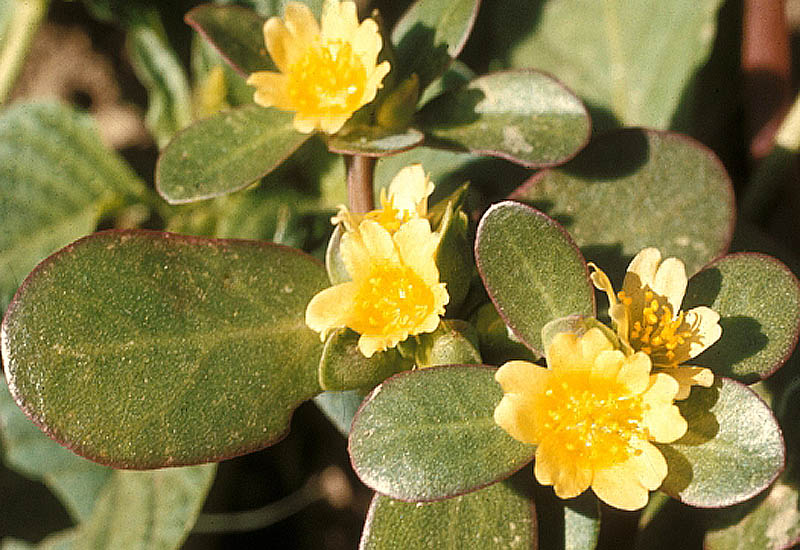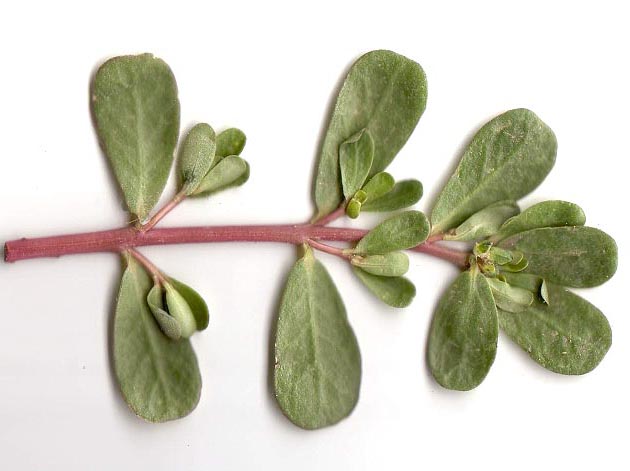This is not the wild prostrate 'weed' that may be growing in your yard right now. This is a much larger stronger plant that grows up to 36 inches (91cm) tall with strong thick stems and flowers that are about 0.75 inches (1.9cm)across and bright yellow gold. Grown mostly as a leafy vegetable it can be added raw to salads and cooked either as a side dish or added to soups and stews. Used extensively in the east and Africa as a vegetable it does produce some mucilage once cooked making it idea to help thicken dishes. Sautéed or stir fried this is reduced. The advantage of this vegetable is that it is very high in omega-3 fatty acid which are most commonly found in nuts but this makes a rich source for those with nut allergies.
Very easy to grow needs full sun, heat and regular water to make the best plants, can be harvested by cutting down plants throughout the year usually growing back up once harvested or can be continually sown. Has a lemony, slightly sharp salty taste. Used as a medicinal herb as its very beneficial to the cardiovascular system, aids in controlling cholesterol levels and can help control appetite in weight loss. Will die at first frost and wildlife enjoy it as much as we do so it will need protection.
Seedlings look just like common purslane but as they grow the fleshy stems become much larger and can reach 0.5 inches (1.2cm) in diameter and are mostly red but can be green or red/green streaked. Leaves are fat and fleshy bright green arranged in linear pairs on the stem mostly oval in shape with pinched end at stem (obovate). Stems can reach 36 inches (91cm) in height and terminate in a usually in a single flower but there may be several. Each node on the stalk can also produce branches and thus flower making the plant a much branched structure. Flowers are bright yellow - leading to the name golden purslane - and consist of five heart shaped petals with deep central lobes surrounding center of up to 10 equally golden colored stamens. Flowers can be up to 0.75 inches (1.9cm) in diameter and show distinctly from a distance making them quite attractive plants.
Seeds need warmth and germinate best at around 70 F (21C) for information on growing see our General Growing Instructions.
Usually germinates within 7-10 days if temperatures are right (over 70F (21C)). If continual harvest is required start first group inside in late winter/early spring then sow next crop outside as long as soil temperatures are above 70F (21C). Keep moist at all times. Transplant inside starts after all danger of frost has passed and overnight temperatures are warm. In warmer areas it can be sown in late winter and produce all summer long.
Light. Full sun and a warm location are essential for good growth.
Soil. Needs to be well drained, does not like wet soils but can tolerate almost any other kind.
Water. Growing as a vegetable it needs regular watering a soaker hose along the base of the plants is ideal as watering the leaves can lead to mold or sun scorch. Water on a regular basis depending on rainfall. In wet or waterlogged soils the roots will rot.
Although this plant is a succulent it needs regular water to ensure the leaves stay fat and flavorful. While it is drought tolerant it causes the plant to become more bitter.
Pollinators like the flowers and even butterflies and larger bees will be attracted since flowers are so much larger on this variety.
In warm zones plants can be cut down to almost ground level and allowed to grow back up and be re-harvested every few weeks. We have not found this to work well in zone 6b plants don't seem to recover as well. Often they will recover from the first cutting but it is not perpetual. However warmer zones may find this method works well.
Alternatively the whole plant can be harvested, by pulling it up by the roots and cutting off the stems as desired. Plants will then have to be replaced by new ones so seeding through the season is required but may be the best option for your zone.
If your plants are prone to attack by leafminer weevil removing the whole plant may be the best option. Then seed or transplant the next set to a different area. This should reduce attacks and allow as much harvesting as possible.
However if you are not watering so the plants dry out then they will become much more tart or sour. This is because the plants change their photosynthesis process to using Crassulacean acid metabolism. This allows them to conserve moisture but also stores carbon dioxide (CO2) which would normally be expelled at night but since they don't want water to escape the CO2 also builds up inside the leaf. Instead it is converted to malic acid which has a sour flavor. This will be converted to glucose for storage during the day but if plants are harvested in the morning they will be a lot more bitter, even afternoon harvest is likely to be more bitter than well watered plants.
Commonly used in soups and stews. When cooked the leaves have a slightly mucilaginous quality thus helping to thicken the dish. Very popular in African and Eastern cuisine where they are used in curries, soups and many other dishes.
Leaves can also be dried for later use.
Seeds. Eaten raw or cooked, they can be ground into flour, mixed with cereals to make any dish made with wheat or other flour. However seeds are small and fiddly to work with plus in most areas plants do not produce sufficient numbers of seeds to be worth the trouble.
The leave are also a different shape. While common purslane has spoon shaped or oval leaves Horse purslane leaves are more round and much wider. While these plants wont kill you if you eat them they really don't taste that great. So check before you eat.







